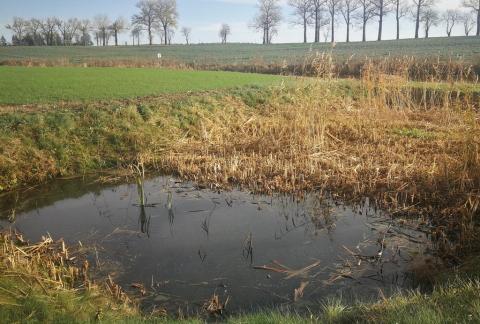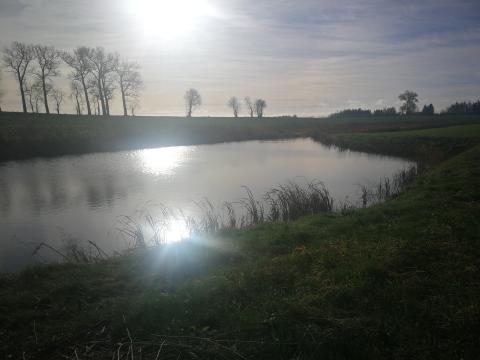Year of Issue
2024
General
Site name
Dotnuvélè River Basin
Summary
Dotnuvėlė river basin covers 192.7 km2. Four reservoirs are situated in the area: near Mantviliškis, Akademija, Dotnuva and near Kėdainiai. The Dotnuvėlė basin is in the Central Lowlands of Lithuania, which is rich in moist soils. Agricultural areas account for 69.2%, forests and other natural areas for 24.5%, artificial surfaces - 5.8%, and water bodies make up only 0.5%. State river monitoring is carried out for this river. The ecological status of the Dotnuvėlė river corresponds to poor (upstream) and medium (downstream) classes.
The OPTAIN project will support the case study team with identifying and developing efficient land management strategies and small technical solutions to improve the soils’ infiltration and water holding capacities as well as its capacity to filter, buffer and transform pollutants.
The OPTAIN project will support the case study team with identifying and developing efficient land management strategies and small technical solutions to improve the soils’ infiltration and water holding capacities as well as its capacity to filter, buffer and transform pollutants.
Project
Optain
Light or indepth?
Light
Transboundary
0
NWRM(s) implemented in the case study
Optain's measures
Longitude
23.792707
Latitude
55.473647
Site information
Remarks
In the lower part of the river Stabė, 1.8 km from its mouth, a wetland of 2.38 ha has been installed. The wetland was constructed by artificially flooding the valley. Corrugated metal plating was used at the inlet and outlet of the wetland to protect the stream banks. While most Lithuanian wetlands are peaty, this one is not. Over time, the surface layer of the wetland has been altered by the hydrophytic wetland-specific plants, their species composition, and the degree of decomposition of these plants. Sediments washed down from the fields accumulate here. The organic matter in these sediments creates the typical habitats of saturated organic soils, which are effective in terms of nitrogen - and especially phosphorus - retention.
The wetland has four main sections. The deepest part covers 0.21 ha and is up to 2.0 m deep. Sediments are deposited here. When there is a decrease in flow, these sediments can then be removed mechanically and transported to fertilize the adjacent fields. The next section covers 0.94 ha and its depth is less than 0.5 m. It is covered with wetland vegetation. The third section works as a filter and the water is aerated. It is protected by a dyke, 6 metres in length, perpendicular to the direction of flow. The dyke is formed from soil and pitched with stone and gravel. The maximum depth of the water in this section is 0.1 metres. The fourth and final section is where the surface water is treated by macropytic vegetation. It covers 1.2 ha and is from 0.2 to 0.5 m deep. Barriers help prolong the period that the water is held.
The wetland was designed to retain nutrients in the spring and reduce their concentrations downstream. Through an ongoing research programme, the impact of the wetland has been monitored from the start. In the first year, vegetation had not become established so there were no impacts. However in 2020 and 2021 there were very positive results in terms of nutrient capture.
The wetland has four main sections. The deepest part covers 0.21 ha and is up to 2.0 m deep. Sediments are deposited here. When there is a decrease in flow, these sediments can then be removed mechanically and transported to fertilize the adjacent fields. The next section covers 0.94 ha and its depth is less than 0.5 m. It is covered with wetland vegetation. The third section works as a filter and the water is aerated. It is protected by a dyke, 6 metres in length, perpendicular to the direction of flow. The dyke is formed from soil and pitched with stone and gravel. The maximum depth of the water in this section is 0.1 metres. The fourth and final section is where the surface water is treated by macropytic vegetation. It covers 1.2 ha and is from 0.2 to 0.5 m deep. Barriers help prolong the period that the water is held.
The wetland was designed to retain nutrients in the spring and reduce their concentrations downstream. Through an ongoing research programme, the impact of the wetland has been monitored from the start. In the first year, vegetation had not become established so there were no impacts. However in 2020 and 2021 there were very positive results in terms of nutrient capture.
Climate zone
cool temperate moist
Mean annual rainfall
600 - 900 mm
Average slope range
Flat (0 -2%)
Monitoring maintenance
Monitoring impacts effects
0
Maintenance requirements
The maintenance activities depend and differ on the year. Not every year there is a need to remove sediments or excessed plants. Sometimes there is a need of reintegration or replacement of plant material, especially after winter.
Administrative costs
5000 EUR
Performance
Performance impact estimation information
The project has had the following impacts:
- Irrigation water quality: increased
- Plant diversity: increased
- Habitat diversity: increased
- Reliable and stable stream flows in dry seasons: increased
- Irrigation water quality: increased
- Plant diversity: increased
- Habitat diversity: increased
- Reliable and stable stream flows in dry seasons: increased
How cost effective
Land user has no maintenance costs and had no establishment costs. The implementation of the project is therefore considered to be positive in terms of cost efficiency
Design & implementations
Project scale
Medium
Installation date
2015
Principles
The main purpose of the proejct was to :
- reduce, prevent, restore land degradation
- conserve ecosystem
- preserve/ improve biodiversity
- adapt to climate change/ extremes and its impacts
- create beneficial economic impact
- reduce, prevent, restore land degradation
- conserve ecosystem
- preserve/ improve biodiversity
- adapt to climate change/ extremes and its impacts
- create beneficial economic impact
Size
2.38
Size unit
ha
Basis of design
The installation of this wetland contributes to reducing the ecological debt to nature by restoring natural complexes, reaching a balance between environmental and economic interests, and promoting sustainable farming conditions in one of the most important and valuable natural areas of central Lithuania.
Public consultation
0
Contractural arrangements
0
Design contractual arrangement
| Arrangement type | Responsibility | Role | Comments | Name |
|---|---|---|---|---|
Design consultation activity
| Activity stage | Key issues | Name | Comments |
|---|---|---|---|
Design land use change
| Land use change type |
|---|
Design authority
| Authority type | Role | Responsibility | Name | Comments |
|---|---|---|---|---|
Lessons, risks, implications...
Financing mechanism
0
Success factor(s)
| Success factor type | Success factor role | Comments |
|---|---|---|
Financing
| Financing type | Comments |
|---|---|
Driver
| Driver type | Driver role | Comments |
|---|---|---|
Financing share
| Financing share type | Share | Comments | |
|---|---|---|---|
Policy, general governance and design targets
Part of wider plan
0
Policy target
| Target purpose |
|---|
Policy pressure
| Pressure directive | Relevant pressure |
|---|---|
Policy area
| Policy area type | Policy area focus | Name | Comments |
|---|---|---|---|
Policy impact
| Impact directive | Relevant impact |
|---|---|
Policy wider plan
| Wider plan type | Wider plan focus | Name | Comments |
|---|---|---|---|
Policy requirement directive
| Requirement directive | Specification |
|---|---|
Photo gallery


